Gibbs Orthodontics in Manhattan is proud to offer braces treatment to our patients, but maybe you need more information on what braces are and the various parts that make up the hardware you would be wearing for several months. The anatomy of braces is rather complex but not difficult to understand.
Once you learn all about braces, we hope you will feel more confident about your choice to seek treatment.
What are braces and how do they work?

Braces are a common orthodontic treatment designed to fix crooked teeth and other misalignments by applying pressure to the teeth to gradually shift them into proper alignment over a period of time that can last anywhere from 15 to 18 months or longer depending on the complexity of your dental problems.
During an appointment, Dr. Gibbs will install your braces by bonding brackets to each tooth using an adhesive. Wires, elastic bands, and other potentially necessary parts help anchor the brackets. The wire is adjusted from time to time to maintain pressure on the teeth so they will continue shifting.
Are there different types of braces?
Yes, there are several braces options to choose from. While similar, each has different technology that involves different parts.
-
Traditional Metal Braces
Traditional metal braces are made of lightweight metals. They feature brackets, an archwire, and elastics that work together to shift your teeth into place.
-
Ceramic Braces
Ceramic braces feature larger brackets but can come in clear or natural tooth color for a less visible treatment.
-
Self-Ligating Braces
Self-ligating braces feature most of the same parts as traditional and ceramic braces, but the way the wire anchors the brackets is different. A special hinged door built into each bracket makes the wire easier to tighten.
-
Lingual Braces
Lingual braces are installed to the back of teeth instead of the front, making the hardware invisible to others when you smile. However, they can be more difficult to install and more uncomfortable, not to mention higher priced.
Parts of Braces
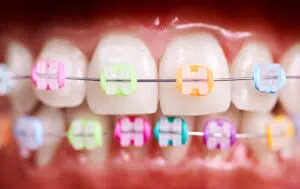
Again, all braces basically utilize the same basic parts, but there are some parts that are different and additional parts that may be necessary. The following guide will help you understand the anatomy of braces.
-
Bracket
Orthodontic brackets are the most visible part of braces. A bracket is bonded to each tooth using a special adhesive. A slot on the brackets is where the archwire will be placed. On the corners of each bracket, you will see tie wings, which are where elastics or ligatures attach to secure the wire. Brackets can come in many different colors and sizes, allowing patients to customize their braces to fit their own style.
-
Archwire
One of the most important parts of braces is the archwire, which is how the orthodontist maintains pressure on the teeth. The wire is a strand of metal that is strung across the teeth and is held by a slot in each bracket. Tightening this wire, which can be made of various metals and comes in different shapes, brings about tooth movement.
-
Molar Bands
Molar bands are small metal rings that an orthodontist places around your back molars. There is a slot for these rings to attach to the brackets. Not every patient will necessarily need molar bands unless your teeth are more difficult to treat with just brackets. Molar bands can also feature an attachment to support headgear.
-
Loop in Archwire
While most archwires don’t need loops, a loop in the archwire is necessary at times to close space between teeth after tooth extraction.
-
Headgear Tube
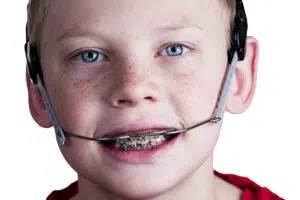
A headgear tube is a special device attached to your back bands so that the inner bow of your headgear will fit into it. Not all braces patients need to wear headgear. It is mostly recommended for children whose jawbones are still developing. The headgear is worn partially outside of the mouth.
-
Coil Spring
A coil spring is another special device that can be attached to your brackets. It is used to pull teeth together to close a space or to push them apart to fix overcrowding. As you can imagine, a coil spring is just a tiny metal spring resembling a Slinky.
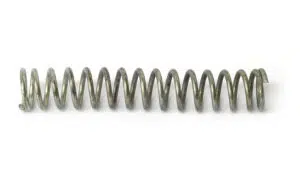
-
Tie Wire
A tie wire is a thin metal wire that is tied over the wire around a bracket. This provides an extra secure hold.
-
Hook
Hooks are small attachments on brackets where rubber bands are attached to add extra pressure.
-
Door
Self-ligating braces feature a device known as a hinged door on the brackets allowing the archwire to basically clip into place. This makes accessing and moving the wire much easier. This is a relatively new technology that makes braces more convenient.
-
Elastic Bands
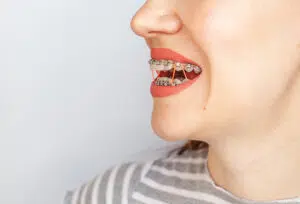
These are basically just small rubber bands that attach to the hook on brackets to apply more pressure.
-
Ligatures
Ligatures are small metal or plastic wires that help attach the archwire to the brackets. They come in a variety of colors and are changed during every visit to your boad-certified orthodontist.
Common Problems and Solutions
-
Loose Band or Bracket
If a band or bracket has come loose, schedule an appointment as soon as possible. This is not a problem you can fix yourself at home. Save any broken pieces and bring them with you.
-
Broken Archwire or Headgear
Again, this problem needs immediate attention because it can cause teeth to shift the wrong way. Make an appointment right away.
-
Lost Ligature or Hook
It’s not uncommon for pieces of your braces to break or become lost. But you should also make an appointment to fix this problem.
-
Irritation Caused by Wire
Sometimes the wire can rub against your mouth tissues and cause irritation. This is a problem patients can fix themselves at home. Try using a pencil eraser to tuck the wire back in. You can also dry the wire off and apply a coat of orthodontic wax.
-
Soreness
There are several methods to handle soreness. Try rinsing with a solution of salt and water, or antiseptic mouthwash. You can also take over-the-counter pain medications. One of the best things you can do to prevent soreness is to keep your teeth and mouth clean.
Contact Us
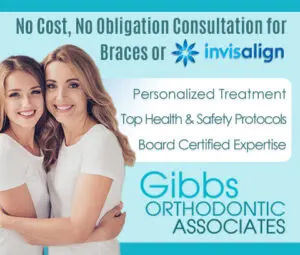
Braces treatment doesn’t have to be a scary mystery. Allow us to show you how the process works. Gibbs Orthodontics is ready to help you on the path to improving your smile. We proudly serve NYC and surrounding communities in Manhattan. For a complimentary consultation, call our office at 212-535-4111 or visit our website today!















